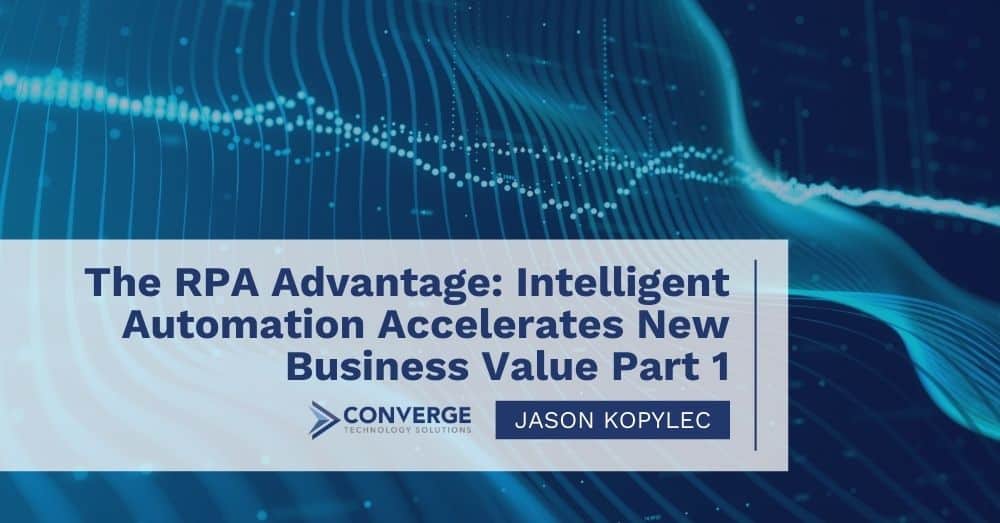Robotic Process Automation (RPA) presents a real opportunity for organizations to drive efficiency and value for their businesses. Automation of time-consuming and complex tasks allows employees to focus on true knowledge work. In this blog, we’ll take a quick look at the history of RPA, how it has evolved, key business use cases, and how to get started with a solution.
A Brief History of RDA/RPA
Robotic Desktop Automation (RDA) has existed for decades in various forms. The first popular examples came into use with the integrated Macro Recorders found in many mainstream operating systems and office applications, such as Word and Excel. Remember when you created your first mail merge using a Word document and an Excel address list? Besides these, and Excel macros that required programming knowledge, none left the desk of the power users to see enterprise-wide success.
Next, QA Automation tools enabled us to point, click, capture, copy, and paste within the constraints of browsers or individual applications. A leap forward in human-like interaction, these solutions were still brittle to application changes and remained trapped as IT-only solutions.
Next came dedicated RDA toolsets aimed at automating activities across different desktop applications. With custom code and platform customizations, we began to deliver true desktop automation solutions to integrate and work across green screen, native, and web-based applications. Vendors introduced process orchestration tools, allowing business users the flexibility of scheduling, setting, and forgetting their repetitive data processing tasks.
RPA Offerings Have Grown Fast
Fast forward, and we move into the world of Robotic Process Automation with tools unbound from desktop runtime and created with orchestration engines in mind from the beginning. The vendor space includes dozens of familiar name brands as well as specialized niche offerings. Gartner has identified several leaders in the field, including UiPath, Automation Anywhere, and Blue Prism. Microsoft, true to form as a successful market late-comer, will likely soon emerge as a top player.
AI-Enabled RPA Is Growing More Powerful
From the outset, RPA mirrored the deterministic, rule-based, decision-tree approach provided by its RDA predecessors. A key breakthrough was the addition of Computer Vision techniques to improve the ability to find user interface elements anywhere on the screen. Given those, we have all the tools we need to tackle repetitive, administrative tasks that work across multiple business applications. We can define, build, and operate robust operational automations.
To truly unleash the power of RPA, we need to push beyond operational automation to expertise automation. Our bots must be able to make decisions and use judgement.
We give our bots eyes, ears, mouths, and brains using the AI techniques of Voice Understanding, Natural Language Processing, Predictive Analytics, and Enterprise Search. Now, they can determine their own trends, probabilities, and likelihoods and choose dynamically between rule sets.
For context, by removing the constraints of only handling structured data—when Natural Language Processing and Vision Learning can be applied to unstructured and image data—we’re now able to address a far larger proportion of business processes without requiring human intervention and review.
Benchmarks.ai shows that in the past eight years, the successful scope of data extraction projects has moved from about 50% to more than 90%.
The authors also call out improving outcomes for image recognition over the past five years. The combined growth of cloud and cognitive computing capabilities have driven operational costs ever lower, reducing barriers to entry.
AI technology that would have been cost-prohibitive only a few years ago is now ready for prime-time integration with RPA at easy-to-consume price points, such that ROI becomes an increasingly easy business justification. Finance and operations management teams welcome Intelligent RPA projects that can realize swift ROI.
What It Takes to Get Started with RPA
When starting out with RPA, it’s important to plan strategically and tactically by selecting business use cases that have the highest likelihood of success, will deliver positive ROI, and will provide improved performance based on common quality metrics such as time savings, error reduction, uniform application of business rules, and overall visible impact.
The folks at AI Multiple have identified 61 candidate projects which you can choose from—all falling within five categories:
- Common business processes and activities
- Sales and CRM
- Support activities: Tech, Finance, HR, Operations, and Procurement
- Industries: Banking, Insurance, Telecom, and Retail
- Personal digital assistants
AI Multiple has catalogued 45 RPA case studies for comparison across industry, business function, results (ROI), and duration to implement:
- Industries: E-Commerce, Energy, Financial Services, Food and Beverage, Healthcare, Insurance, Logistics, Manufacturing, Non-profit/Government, Printing, Professional Services, Tech, Telecom, and Utility
- Business Functions: Administrative, Customer Service, Finance, HR, IT, Operations, and Technology
- ROI: Various measurements of efficiency, cost reduction, resource utilization, and team size
- Implementation: Some as brief as six weeks to delivery
Moving from a One-Off Project to an Enterprise-Grade Solution
Taking RPA to the enterprise brings increased expectations and service-level agreement requirements. While early adopters of RPA and RPA orchestration found success with on-premises implementations, the adoption of cloud and hybrid-cloud implementations is growing. The strength and resilience of well-architected cloud environments provides the infrastructure for world-class operating efficiency at scale.
Learn How RPA Can Support Digital Transformation Initiatives
Whether a company is just starting to think about automation or is already well down the path, the right RPA solution and partner can help uncover new possibilities for automation and deliver new efficiencies in the form of time and cost savings.
Watch our on-demand webinar, Accelerating Digital Transformation, to learn how businesses around the world are using RPA to enable straight-through processing and maintain customer experience and quality of operation while drastically reducing the cost of operations. Stay tuned for my next blog, where we’ll dive into how RPA drove smart efficiency for a legal organization!





